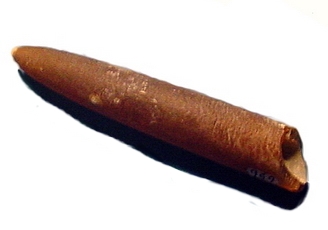
Paleontology in Indiana refers to paleontological research occurring within or conducted by people from the U.S. state of Indiana. Indiana's fossil record stretches all the way back to the Precambrian, when the state was inhabited by microbes. More complex organisms came to inhabit the state during the early Paleozoic era. At that time the state was covered by a warm shallow sea that would come to be inhabited by creatures like brachiopods, bryozoans, cephalopods, crinoids, and trilobites. During the Silurian period the state was home to significant reef systems. Indiana became a more terrestrial environment during the Carboniferous, as an expansive river system formed richly vegetated deltas where amphibians lived. There is a gap in the local rock record from the Permian through the Mesozoic. Likewise, little is known about the early to middle Cenozoic era. During the Ice Age however, the state was subject to glacial activity, and home to creatures like short-faced bears, camels, mammoths, and mastodons. After humans came to inhabit the state, Native Americans interpreted the fossil proboscidean remains preserved near Devil's Lake as the bones of water monsters. After the advent of formal scientific investigation one paleontological survey determined that the state was home to nearly 150 different kinds of prehistoric plants.
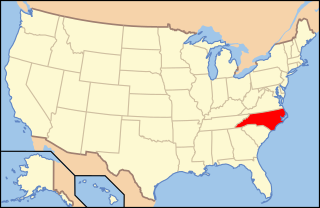
Paleontology in North Carolina refers to paleontological research occurring within or conducted by people from the U. S. state of North Carolina. Fossils are common in North Carolina. According to author Rufus Johnson, "almost every major river and creek east of Interstate 95 has exposures where fossils can be found". The fossil record of North Carolina spans from Eocambrian remains that are 600 million years old, to the Pleistocene 10,000 years ago.
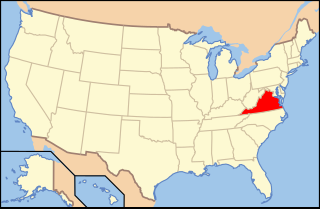
Paleontology in Virginia refers to paleontological research occurring within or conducted by people from the U.S. state of Virginia. The geologic column in Virginia spans from the Cambrian to the Quaternary. During the early part of the Paleozoic, Virginia was covered by a warm shallow sea. This sea would come to be inhabited by creatures like brachiopods, bryozoans, corals, and nautiloids. The state was briefly out of the sea during the Ordovician, but by the Silurian it was once again submerged. During this second period of inundation the state was home to brachiopods, trilobites and entire reef systems. During the mid-to-late Carboniferous the state gradually became a swampy environment.
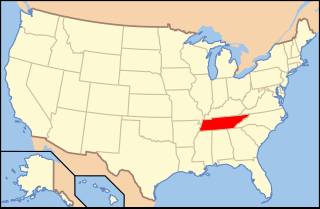
Paleontology in Tennessee refers to paleontological research occurring within or conducted by people from the U.S. state of Tennessee. During the early part of the Paleozoic era, Tennessee was covered by a warm, shallow sea. This sea was home to brachiopods, bryozoans, cephalopods, corals, and trilobites. Tennessee is one of the best sources of Early Devonian fossils in North America. During the mid-to-late Carboniferous, the state became a swampy environment, home to a rich variety of plants including ferns and scale trees. A gap in the local rock record spans from the Permian through the Jurassic. During the Cretaceous, the western part of the state was submerged by seawater. The local waters were home to more fossil gastropods than are known from anywhere else in the world. Mosasaurs and sea turtles also inhabited these waters. On land the state was home to dinosaurs. Western Tennessee was still under the sea during the early part of the Cenozoic. Terrestrial portions of the state were swampy. Climate cooled until the Ice Age, when the state was home to Camelops, horses, mammoths, mastodons, and giant ground sloths. The local Yuchi people told myths of giant lizard monsters that may have been inspired by fossils either local or encountered elsewhere. In 1920, after local fossils became a subject of formal scientific study, a significant discovery of a variety of Pleistocene creatures was made near Nashville. The Cretaceous bivalve Pterotrigonia thoracica is the Tennessee state fossil.
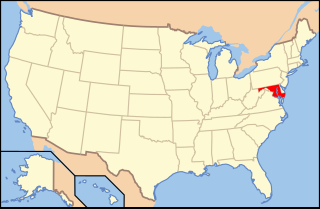
Paleontology in Maryland refers to paleontological research occurring within or conducted by people from the U.S. state of Maryland. The invertebrate fossils of Maryland are similar to those of neighboring Delaware. For most of the early Paleozoic era, Maryland was covered by a shallow sea, although it was above sea level for portions of the Ordovician and Devonian. The ancient marine life of Maryland included brachiopods and bryozoans while horsetails and scale trees grew on land. By the end of the era, the sea had left the state completely. In the early Mesozoic, Pangaea was splitting up. The same geologic forces that divided the supercontinent formed massive lakes. Dinosaur footprints were preserved along their shores. During the Cretaceous, the state was home to dinosaurs. During the early part of the Cenozoic era, the state was alternatingly submerged by sea water or exposed. During the Ice Age, mastodons lived in the state.

Paleontology in Pennsylvania refers to paleontological research occurring within or conducted by people from the U.S. state of Pennsylvania. The geologic column of Pennsylvania spans from the Precambrian to Quaternary. During the early part of the Paleozoic, Pennsylvania was submerged by a warm, shallow sea. This sea would come to be inhabited by creatures like brachiopods, bryozoans, crinoids, graptolites, and trilobites. The armored fish Palaeaspis appeared during the Silurian. By the Devonian the state was home to other kinds of fishes. On land, some of the world's oldest tetrapods left behind footprints that would later fossilize. Some of Pennsylvania's most important fossil finds were made in the state's Devonian rocks. Carboniferous Pennsylvania was a swampy environment covered by a wide variety of plants. The latter half of the period was called the Pennsylvanian in honor of the state's rich contemporary rock record. By the end of the Paleozoic the state was no longer so swampy. During the Mesozoic the state was home to dinosaurs and other kinds of reptiles, who left behind fossil footprints. Little is known about the early to mid Cenozoic of Pennsylvania, but during the Ice Age it seemed to have a tundra-like environment. Local Delaware people used to smoke mixtures of fossil bones and tobacco for good luck and to have wishes granted. By the late 1800s Pennsylvania was the site of formal scientific investigation of fossils. Around this time Hadrosaurus foulkii of neighboring New Jersey became the first mounted dinosaur skeleton exhibit at the Academy of Natural Sciences in Philadelphia. The Devonian trilobite Phacops rana is the Pennsylvania state fossil.

Paleontology in South Carolina refers to paleontological research occurring within or conducted by people from the U.S. state of South Carolina. Evidence suggests that at least part of South Carolina was covered by a warm, shallow sea and inhabited by trilobites during the Cambrian period. Other than this, little is known about the earliest prehistory of South Carolina because the Ordovician, Silurian, Devonian, Carboniferous, Permian, Triassic, and Jurassic, are missing from the state's local rock record. The earliest fossils of South Carolina date back to the Cretaceous, when the state was partially covered by seawater. Contemporary fossils include marine invertebrates and the remains of dinosaur carcasses that washed out to sea. On land, a wide variety of trees grew. Sea levels rose and fell throughout the ensuing Cenozoic era. Local marine life included invertebrates, fish, sharks, whales. The first scientifically accurate identification of vertebrate fossils in North America occurred in South Carolina. In 1725, African slaves digging in a swamp uncovered mammoth teeth, which they recognized as originating from an elephant-like animal.
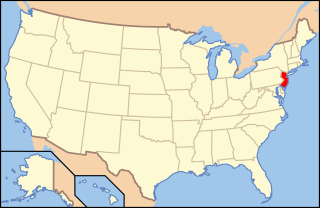
Paleontology in New Jersey refers to paleontological research in the US state of New Jersey. The state is especially rich in marine deposits.

Paleontology in Georgia refers to paleontological research occurring within or conducted by people from the U.S. state of Georgia. During the early part of the Paleozoic, Georgia was largely covered by seawater. Although no major Paleozoic discoveries have been uncovered in Georgia, the local fossil record documents a great diversity of ancient life in the state. Inhabitants of Georgia's early Paleozoic sea included corals, stromatolites, and trilobites. During the Carboniferous local sea levels dropped and a vast complex of richly vegetated delta formed in the state. These swampy deltas were home to early tetrapods which left behind footprints that would later fossilize. Little is known of Triassic Georgia and the Jurassic is absent altogether from the state's rock record. During the Cretaceous, however, southern Georgia was covered by a sea that was home to invertebrates and fishes. On land, the tree Araucaria grew, and dinosaurs inhabited the state. Southern Georgia remained submerged by shallow seawater into the ensuing Paleogene and Neogene periods of the Cenozoic era. These seas were home to small coral reefs and a variety of other marine invertebrates. By the Pleistocene the state was mostly dry land covered in forests and grasslands home to mammoths and giant ground sloths. Local coal mining activity has a history of serendipitous Carboniferous-aged fossil discoveries. Another major event in Georgian paleontology was a 1963 discovery of Pleistocene fossils in Bartow County. Shark teeth are the Georgia state fossil.
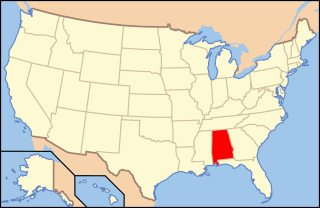
Paleontology in Alabama refers to paleontological research occurring within or conducted by people from the U.S. state of Alabama. Pennsylvanian plant fossils are common, especially around coal mines. During the early Paleozoic, Alabama was at least partially covered by a sea that would end up being home to creatures including brachiopods, bryozoans, corals, and graptolites. During the Devonian the local seas deepened and local wildlife became scarce due to their decreasing oxygen levels.

Paleontology in Massachusetts refers to paleontological research occurring within or conducted by people from the U.S. state of Massachusetts. The fossil record of Massachusetts is very similar to that of neighboring Connecticut. During the early part of the Paleozoic era, Massachusetts was covered by a warm shallow sea, where brachiopods and trilobites would come to live. No Carboniferous or Permian fossils are known from the state. During the Cretaceous period the area now occupied by the Elizabeth Islands and Martha's Vineyard were a coastal plain vegetated by flowers and pine trees at the edge of a shallow sea. No rocks are known of Paleogene or early Neogene age in the state, but during the Pleistocene evidence indicates that the state was subject to glacial activity and home to mastodons. The local fossil theropod footprints of Massachusetts may have been at least a partial inspiration for the Tuscarora legend of the Mosquito Monster or Great Mosquito in New York. Local fossils had already caught the attention of scientists by 1802 when dinosaur footprints were discovered in the state. Other notable discoveries include some of the first known fossil of primitive sauropodomorphs and Podokesaurus. Dinosaur tracks are the Massachusetts state fossil.

Paleontology in Mississippi refers to paleontological research occurring within or conducted by people from the U.S. state of Mississippi. The oldest rocks in Mississippi date back to the Late Devonian. At the time, the northeastern part of the state was covered in a sea where brachiopods, crinoids, and trilobites lived. Remains of contemporary local plants also ended up preserved in this environment. During the Late Carboniferous, Mississippi became part of a richly-vegetated coastal plain environment. There are no rocks dating to the Permian, Triassic, or Jurassic in the state. However, during the Cretaceous, evidence suggests that the state was covered by a sea home to cephalopods, mosasaurs and sharks. Local trees left behind petrified wood and amber. By the Cenozoic, only the southern half of the state was covered in seawater, where the early whale Basilosaurus lived. On land, trees that were home to some of the earliest known primates left behind petrified wood. For the remainder of the Cenozoic, the state's climate cooled. Many fossils have been serendipitously discovered in the state by people looking for fossil fuels. Significant fossil finds in Mississippi include some of the oldest known primate fossils. The Eocene whales Basilosaurus cetoides and Zygorhiza kochii are the Mississippi state fossils.

Paleontology in Vermont refers to paleontological research occurring within or conducted by people from the U.S. state of Vermont. Fossils are generally uncommon in Vermont. Nevertheless, however, significant finds have been made in the state. Very few fossils are known in Vermont east of the Green Mountains due to the type of rock underlying that area. During the early part of the Paleozoic era, Vermont was covered by a warm, shallow sea that would end up being home to creatures like brachiopods, corals, crinoids, ostracoderms, and trilobites. There are no rocks in the state from the Carboniferous, Permian, Triassic, or Jurassic periods. The few Cretaceous rocks present contain no fossils. The Paleogene and Neogene periods are also absent from the local rock record. During the Ice Age, glaciers scoured the state. At times the state was inundated by seawater, allowing marine mammals to venture in. After the seawater drained away the state was home to mastodons. Local fossils had already attracted scientific attention by the mid-19th century when mastodon remains were found in Rutland County. In 1950 a major Paleozoic invertebrate find occurred. The Pleistocene Beluga whale Delphinapterus leucas is the Vermont state fossil.
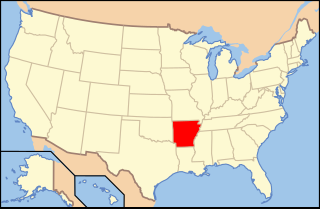
Paleontology in Arkansas refers to paleontological research occurring within or conducted by people from the U.S. state of Arkansas. The fossil record of Arkansas spans from the Ordovician to the Eocene. Nearly all of the state's fossils have come from ancient invertebrate life. During the early Paleozoic, much of Arkansas was covered by seawater. This sea would come to be home to creatures including Archimedes, brachiopods, and conodonts. This sea would begin its withdrawal during the Carboniferous, and by the Permian the entire state was dry land. Terrestrial conditions continued into the Triassic, but during the Jurassic, another sea encroached into the state's southern half. During the Cretaceous the state was still covered by seawater and home to marine invertebrates such as Belemnitella. On land the state was home to long necked sauropod dinosaurs, who left behind footprints and ostrich dinosaurs such as Arkansaurus.
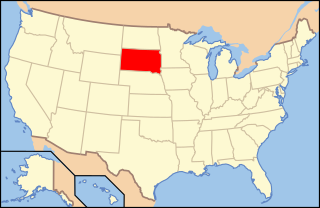
Paleontology in South Dakota refers to paleontological research occurring within or conducted by people from the U.S. state of South Dakota. South Dakota is an excellent source of fossils as finds have been widespread throughout the state. During the early Paleozoic era South Dakota was submerged by a shallow sea that would come to be home to creatures like brachiopods, cephalopods, corals, and ostracoderms. Local sea levels rose and fall during the Carboniferous and the sea left completely during the Permian. During the Triassic, the state became a coastal plain, but by the Jurassic it was under a sea where ammonites lived. Cretaceous South Dakota was also covered by a sea that was home to mosasaurs. The sea remained in place after the start of the Cenozoic before giving way to a terrestrial mammal fauna including the camel Poebrotherium, three-toed horses, rhinoceroses, saber teeth, and titanotheres. During the Ice Age glaciers entered the state, which was home to mammoths and mastodons. Local Native Americans interpreted fossils as the remains of the water monster Unktehi and used bits of Baculites shells in magic rituals to summon buffalo herds. Local fossils came to the attention of formally trained scientists with the Lewis and Clark expedition. The Cretaceous horned dinosaur Triceratops horridus is the South Dakota state fossil.

Paleontology in Texas refers to paleontological research occurring within or conducted by people from the U.S. state of Texas. Author Marian Murray has remarked that "Texas is as big for fossils as it is for everything else." Some of the most important fossil finds in United States history have come from Texas. Fossils can be found throughout most of the state. The fossil record of Texas spans almost the entire geologic column from Precambrian to Pleistocene. Shark teeth are probably the state's most common fossil. During the early Paleozoic era Texas was covered by a sea that would later be home to creatures like brachiopods, cephalopods, graptolites, and trilobites. Little is known about the state's Devonian and early Carboniferous life. However, evidence indicates that during the late Carboniferous the state was home to marine life, land plants and early reptiles. During the Permian, the seas largely shrank away, but nevertheless coral reefs formed in the state. The rest of Texas was a coastal plain inhabited by early relatives of mammals like Dimetrodon and Edaphosaurus. During the Triassic, a great river system formed in the state that was inhabited by crocodile-like phytosaurs. Little is known about Jurassic Texas, but there are fossil aquatic invertebrates of this age like ammonites in the state. During the Early Cretaceous local large sauropods and theropods left a great abundance of footprints. Later in the Cretaceous, the state was covered by the Western Interior Seaway and home to creatures like mosasaurs, plesiosaurs, and few icthyosaurs. Early Cenozoic Texas still contained areas covered in seawater where invertebrates and sharks lived. On land the state would come to be home to creatures like glyptodonts, mammoths, mastodons, saber-toothed cats, giant ground sloths, titanotheres, uintatheres, and dire wolves. Archaeological evidence suggests that local Native Americans knew about local fossils. Formally trained scientists were already investigating the state's fossils by the late 1800s. In 1938, a major dinosaur footprint find occurred near Glen Rose. Pleurocoelus was the Texas state dinosaur from 1997 to 2009, when it was replaced by Paluxysaurus jonesi after the Texan fossils once referred to the former species were reclassified to a new genus.

Paleontology in Utah refers to paleontological research occurring within or conducted by people from the U.S. state of Utah. Utah has a rich fossil record spanning almost all of the geologic column. During the Precambrian, the area of northeastern Utah now occupied by the Uinta Mountains was a shallow sea which was home to simple microorganisms. During the early Paleozoic Utah was still largely covered in seawater. The state's Paleozoic seas would come to be home to creatures like brachiopods, fishes, and trilobites. During the Permian the state came to resemble the Sahara desert and was home to amphibians, early relatives of mammals, and reptiles. During the Triassic about half of the state was covered by a sea home to creatures like the cephalopod Meekoceras, while dinosaurs whose footprints would later fossilize roamed the forests on land. Sand dunes returned during the Early Jurassic. During the Cretaceous the state was covered by the sea for the last time. The sea gave way to a complex of lakes during the Cenozoic era. Later, these lakes dissipated and the state was home to short-faced bears, bison, musk oxen, saber teeth, and giant ground sloths. Local Native Americans devised myths to explain fossils. Formally trained scientists have been aware of local fossils since at least the late 19th century. Major local finds include the bonebeds of Dinosaur National Monument. The Jurassic dinosaur Allosaurus fragilis is the Utah state fossil.
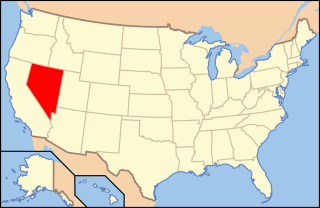
Paleontology in Nevada refers to paleontological research occurring within or conducted by people from the U.S. state of Nevada. Nevada has a rich fossil record of plants and animal life spanning the past 650 million years of time. The earliest fossils from the state are from Esmeralda County, and are Late Proterozoic in age and represent reefs of photosynthesizing blue-green algae, amongst these reefs were some of the oldest known shells in the fossil record, the Cloudina-fauna. Much of the Proterozoic and Paleozoic fossil story of Nevada is that of a warm, shallow, tropical sea, with a few exceptions towards the Late Paleozoic. As such many fossils across the state are those of marine animals, such as trilobites, brachiopods, bryozoans, honeycomb corals, and horn corals.

Paleontology in Washington encompasses paleontological research occurring within or conducted by people from the U.S. state of Washington. Washington has a rich fossil record spanning almost the entire geologic column. Its fossil record shows an unusually great diversity of preservational types including carbonization, petrifaction, permineralization, molds, and cast. Early Paleozoic Washington would come to be home to creatures like archaeocyathids, brachiopods, bryozoans, cephalopods, corals, and trilobites. While some Mesozoic fossils are known, few dinosaur remains have been found in the state. Only about two thirds of the state's land mass had come together by the time the Mesozoic ended. In the Cenozoic the state's sea began to withdraw towards the west, while local terrestrial environments were home to a rich variety of trees and insects. Vertebrates would come to include the horse Hipparion, bison, camels, caribou, oreodonts. Later, during the Ice Age, the northern third of the state was covered in glaciers while creatures like bison, caribou, woolly mammoths, mastodons, and rhinoceros roamed elsewhere in the state. The Pleistocene Columbian Mammoth, Mammuthus columbi is the Washington state fossil.

The prehistory of the United States comprises the occurrences within regions now part of the United States of America during the interval of time spanning from the formation of the Earth to the documentation of local history in written form. At the start of the Paleozoic era, what is now "North" America was actually in the southern hemisphere. Marine life flourished in the country's many seas, although terrestrial life had not yet evolved. During the latter part of the Paleozoic, seas were largely replaced by swamps home to amphibians and early reptiles. When the continents had assembled into Pangaea drier conditions prevailed. The evolutionary precursors to mammals dominated the country until a mass extinction event ended their reign.

